Interannual, Seasonal, and Monthly Variability of Sea Surface Temperature Fronts in Offshore China from 1982–2021
Abstract
1. Introduction
2. Materials and Methods
2.1. Study Area and Location of SST Fronts
2.2. SST Data
2.3. Frontal Detection Algorithm
2.4. Parameter Used for Describing Fronts
3. Results
3.1. Monthly Variability of SST Front in OC
3.2. Seasonal Variability of SST Front in OC
3.3. Interannual Variability of SST Front in OC
4. Discussion
4.1. Fronts in the Bohai
4.2. New Front in the Yellow Sea
5. Conclusions
Author Contributions
Funding
Data Availability Statement
Conflicts of Interest
References
- Belkin, I.M.; Cornillon, P.C.; Sherman, K. Fronts in large marine ecosystems. Prog. Oceanogr. 2009, 81, 223–236. [Google Scholar] [CrossRef]
- Bava, J.; Gagliardini, D.A.; Dogliotti, A.I.; Lasta, C.A. Annual distribution and variability of remotely sensed sea surface temperature fronts in the Southwestern Atlantic Ocean. In Proceedings of the 29th International Symposium on Remote Sensing of Environment, Buenos Aires, Argentina, 8–12 April 2002. [Google Scholar]
- Hopkins, J.; Challenor, P.; Shaw, A.G.P. A new statistical modeling approach to ocean front detection from SST satellite images. J. Atmos. Ocean. Technol. 2010, 27, 173–191. [Google Scholar] [CrossRef]
- Chen, H.H.; Qi, Y.; Wang, Y.; Chai, F. Seasonal variability of SST fronts and winds on the southeastern continental shelf of Brazil. Ocean. Dyn. 2019, 69, 1387–1399. [Google Scholar] [CrossRef]
- Guo, L.; Xiu, P.; Chai, F.; Xue, H.; Wang, D.; Sun, J. Enhanced chlorophyll concentrations induced by Kuroshio intrusion fronts in the northern South China Sea. Geophys. Res. Lett. 2017, 44, 11565–11572. [Google Scholar] [CrossRef]
- Lü, X.; Qiao, F.; Xia, C.; Zhu, J.; Yuan, Y. Upwelling off Yangtze River estuary in summer. J. Geophys. Res. Ocean. 2006, 111. [Google Scholar] [CrossRef]
- Tsopouridis, L.; Spensberger, C.; Spengler, T. Cyclone intensification in the Kuroshio region and its relation to the sea surface temperature front and upper-level forcing. Q. J. R. Meteorol. Soc. 2021, 147, 485–500. [Google Scholar] [CrossRef]
- Belkin, I.M. Remote sensing of ocean fronts in marine ecology and fisheries. Remote Sens. 2021, 13, 883. [Google Scholar] [CrossRef]
- Tseng, C.T.; Sun, C.L.; Belkin, I.M.; Yeh, S.-Z.; Kuo, C.-L.; Liu, D.-C. Sea surface temperature fronts affect distribution of Pacific saury (Cololabis saira) in the Northwestern Pacific Ocean. Deep. Sea Res. Part II Top. Stud. Oceanogr. 2014, 107, 15–21. [Google Scholar] [CrossRef]
- Belkin, I.; Cornillon, P. SST fronts of the Pacific coastal and marginal seas. Pacifific Oceanogr. 2003, 1, 90–113. [Google Scholar]
- Belkin, I.M.; Cornillon, P.C. Bering Sea thermal fronts from Pathfifinder data: Seasonal and interannual variability. Pacifific Oceanogr. 2005, 3, 6–20. [Google Scholar]
- Ping, B.; Su, F.; Meng, Y.; Du, Y.; Fang, S. Application of a sea surface temperature front composite algorithm in the Bohai, Yellow, and East China Seas. Chin. J. Oceanol. Limnol. 2016, 34, 597–607. [Google Scholar] [CrossRef]
- Legeckis, R. A survey of worldwide sea surface temperature fronts detected by environmental satellites. J. Geophys. Res. Ocean. 1978, 83, 4501–4522. [Google Scholar] [CrossRef]
- Wang, Y.; Castelao, R.M.; Yuan, Y. Seasonal variability of alongshore winds and sea surface temperature fronts in Eastern Boundary Current Systems. J. Geophys. Res. Ocean. 2015, 120, 2385–2400. [Google Scholar] [CrossRef]
- Canny, J. A computational approach to edge detection. IEEE Trans. Pattern Anal. Mach. Intell. 1986, 6, 679–698. [Google Scholar] [CrossRef]
- Cayula, J.F.; Cornillon, P. Edge detection algorithm for SST images. J. Atmos. Ocean. Technol. 1992, 9, 67–80. [Google Scholar] [CrossRef]
- Cayula, J.F.; Cornillon, P. Multi-image edge detection for SST images. J. Atmos. Ocean. Technol. 1995, 12, 821–829. [Google Scholar] [CrossRef]
- Belkin, I.M.; O’Reilly, J.E. An algorithm for oceanic front detection in chlorophyll and SST satellite imagery. J. Mar. Syst. 2009, 78, 319–326. [Google Scholar] [CrossRef]
- Nieto, K.; Demarcq, H.; McClatchie, S. Mesoscale frontal structures in the Canary Upwelling System: New front and filament detection algorithms applied to spatial and temporal patterns. Remote Sens. Environ. 2012, 123, 339–346. [Google Scholar] [CrossRef]
- Mauzole, Y.L. Objective delineation of persistent SST fronts based on global satellite observations. Remote Sens. Environ. 2022, 269, 112798. [Google Scholar] [CrossRef]
- Wang, Y.; Yu, Y.; Zhang, Y.; Zhang, H.R.; Chai, F. Distribution and variability of sea surface temperature fronts in the South China Sea. Estuar. Coast. Shelf Sci. 2020, 240, 106793. [Google Scholar] [CrossRef]
- Zeng, X.; Belkin, I.M.; Peng, S.; Li, Y. East Hainan upwelling fronts detected by remote sensing and modelled in summer. Int. J. Remote Sens. 2014, 35, 4441–4451. [Google Scholar] [CrossRef]
- Castelao, R.M.; Wang, Y. Wind—driven variability in sea surface temperature front distribution in the California Current System. J. Geophys. Res. Ocean. 2014, 119, 1861–1875. [Google Scholar] [CrossRef]
- Bai, H.; Hu, H.; Yang, X.Q.; Ren, X.; Xu, H.; Liu, G. Modeled MABL responses to the winter Kuroshio SST front in the East China Sea and Yellow Sea. J. Geophys. Res. Atmos. 2019, 124, 6069–6092. [Google Scholar] [CrossRef]
- Hickox, R.; Belkin, I.; Cornillon, P.; Shan, Z. Climatology and seasonal variability of ocean fronts in the East China, Yellow and Bohai Seas from satellite SST data. Geophys. Res. Lett. 2000, 27, 2945–2948. [Google Scholar] [CrossRef]
- Liu, Z.; Hou, Y. Kuroshio Front in the East China sea from satellite SST and remote sensing data. IEEE Geosci. Remote Sens. Letters 2011, 9, 517–520. [Google Scholar] [CrossRef]
- He, S.; Huang, D.; Zeng, D. Double SST fronts observed from MODIS data in the East China Sea off the Zhejiang–Fujian coast, China. J. Mar. Syst. 2016, 154, 93–102. [Google Scholar] [CrossRef]
- Cao, L.; Tang, R.; Huang, W.; Wang, Y. Seasonal variability and dynamics of coastal sea surface temperature fronts in the East China Sea. Ocean. Dyn. 2021, 71, 237–249. [Google Scholar] [CrossRef]
- Lin, L.; Liu, D.; Luo, C.; Xie, L. Double fronts in the Yellow Sea in summertime identified using sea surface temperature data of multi-scale ultra-high resolution analysis. Cont. Shelf Res. 2019, 175, 76–86. [Google Scholar] [CrossRef]
- Ren, S.; Zhu, X.; Drevillon, M.; Wang, H.; Zhang, Y.; Zu, Z.; Li, A. Detection of SST Fronts from a High-Resolution Model and Its Preliminary Results in the South China Sea. J. Atmos. Ocean. Technol. 2021, 38, 387–403. [Google Scholar] [CrossRef]
- Jing, Z.; Qi, Y.; Fox-Kemper, B.; Du, Y.; Lian, S. Seasonal thermal fronts on the northern South China Sea shelf: Satellite measurements and three repeated field surveys. J. Geophys. Res. Ocean. 2016, 121, 1914–1930. [Google Scholar] [CrossRef]
- Shi, R.; Guo, X.; Wang, D.; Zeng, L.; Chen, J. Seasonal variability in coastal fronts and its influence on sea surface wind in the northern South China Sea. Deep. Sea Res. Part II Top. Stud. Oceanogr. 2015, 119, 30–39. [Google Scholar] [CrossRef]
- Reynolds, R.W.; Smith, T.M.; Liu, C.; Chelton, D.B.; Casey, K.S.; Schlax, M.G. Daily high-resolution-blended analyses for sea surface temperature. J. Clim. 2007, 20, 5473–5496. [Google Scholar] [CrossRef]
- Huang, B.; Liu, C.; Freeman, E.; Graham, G.; Smith, T.; Zhang, H.M. Assessment and intercomparison of NOAA daily optimum interpolation sea surface temperature (DOISST) version 2.1. J. Clim. 2021, 34, 7421–7441. [Google Scholar] [CrossRef]
- Suhadha, A.G.; Ibrahim, A. Association study between thermal front phenomena and Bali sardinella fishing areas in Bali Strait. Indones. J. Geogr. 2020, 52, 154–162. [Google Scholar] [CrossRef]
- Roberts, J.J.; Best, B.D.; Dunn, D.C.; Treml, E.A.; Halpin, P.N. Marine Geospatial Ecology Tools: An integrated framework for ecological geoprocessing with ArcGIS, Python, R, MATLAB, and C++. Environ. Model. Softw. 2010, 25, 1197–1207. [Google Scholar] [CrossRef]

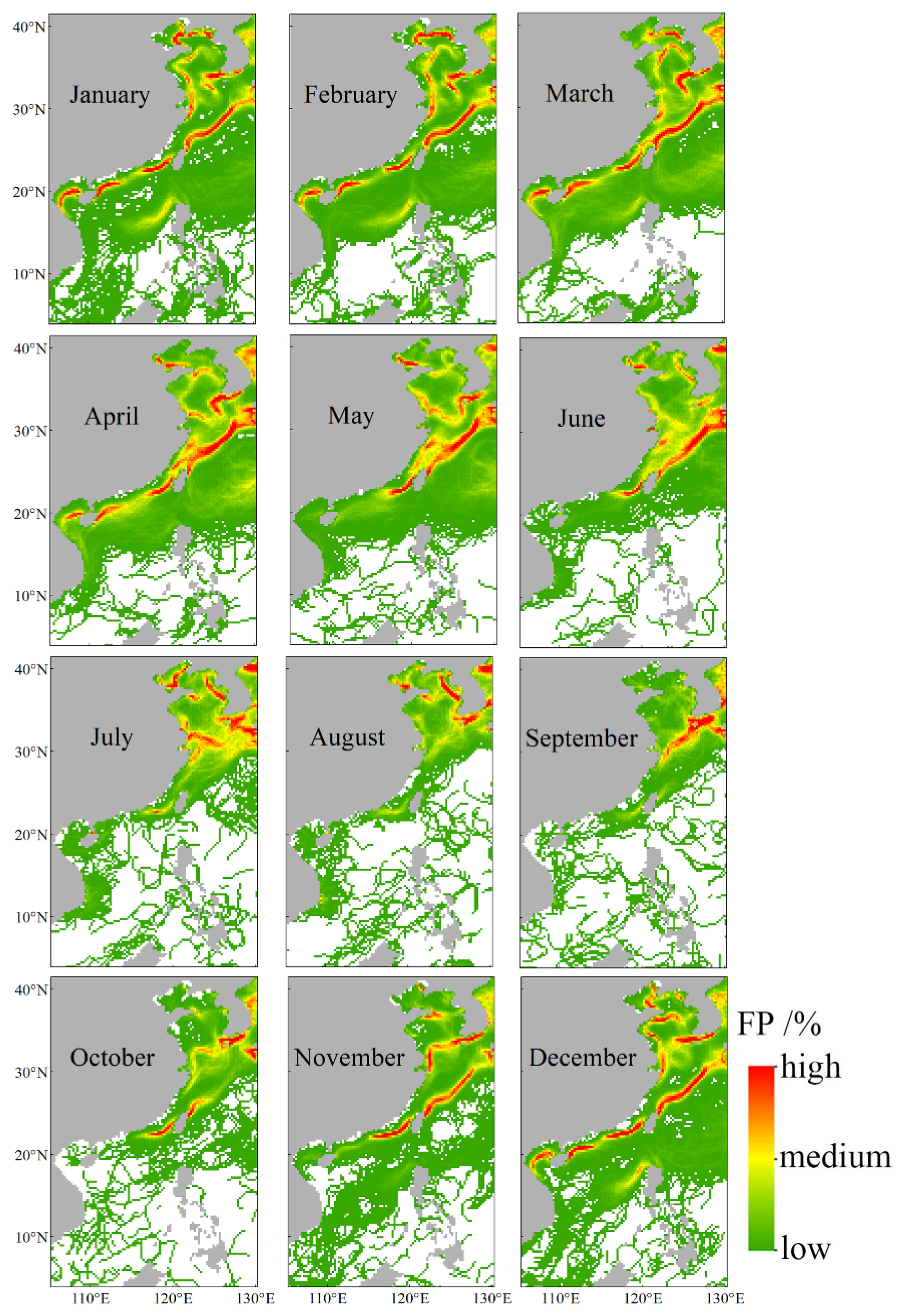
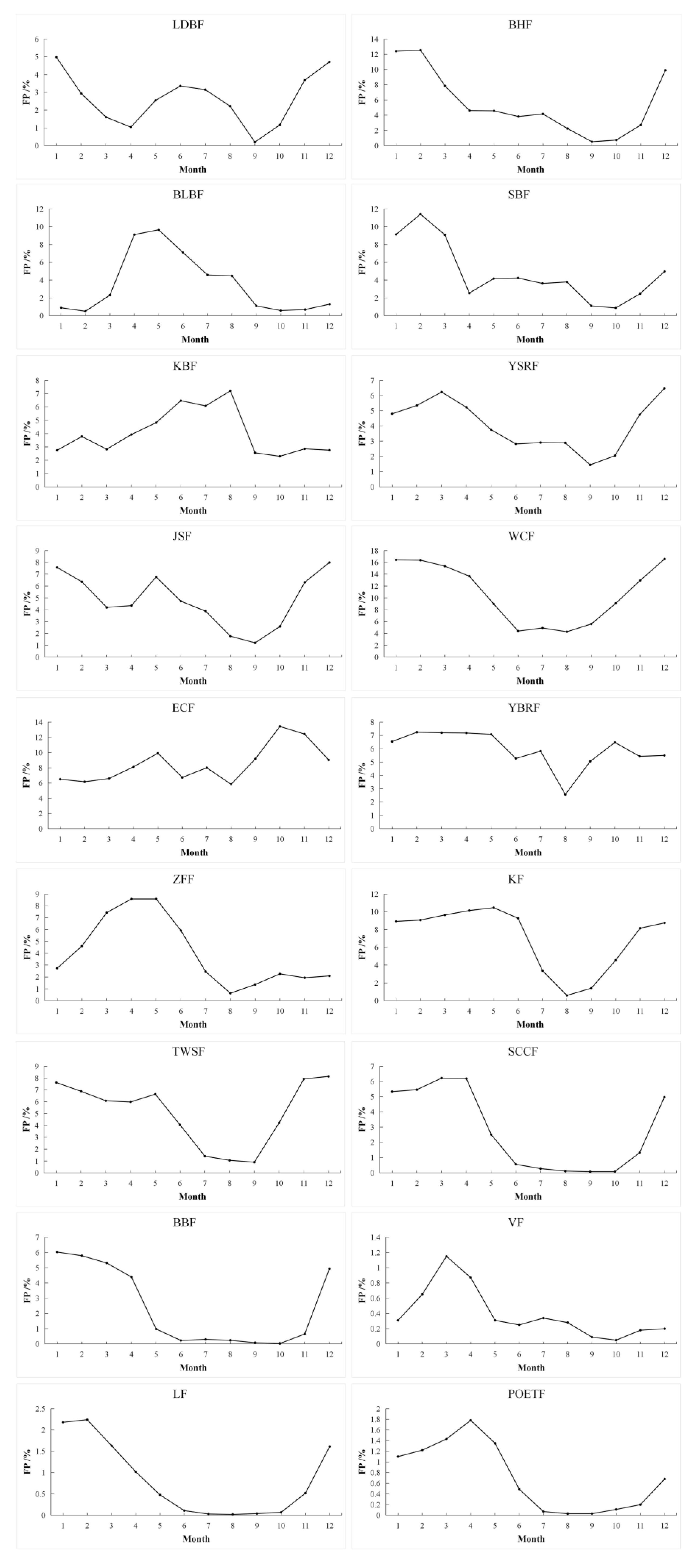
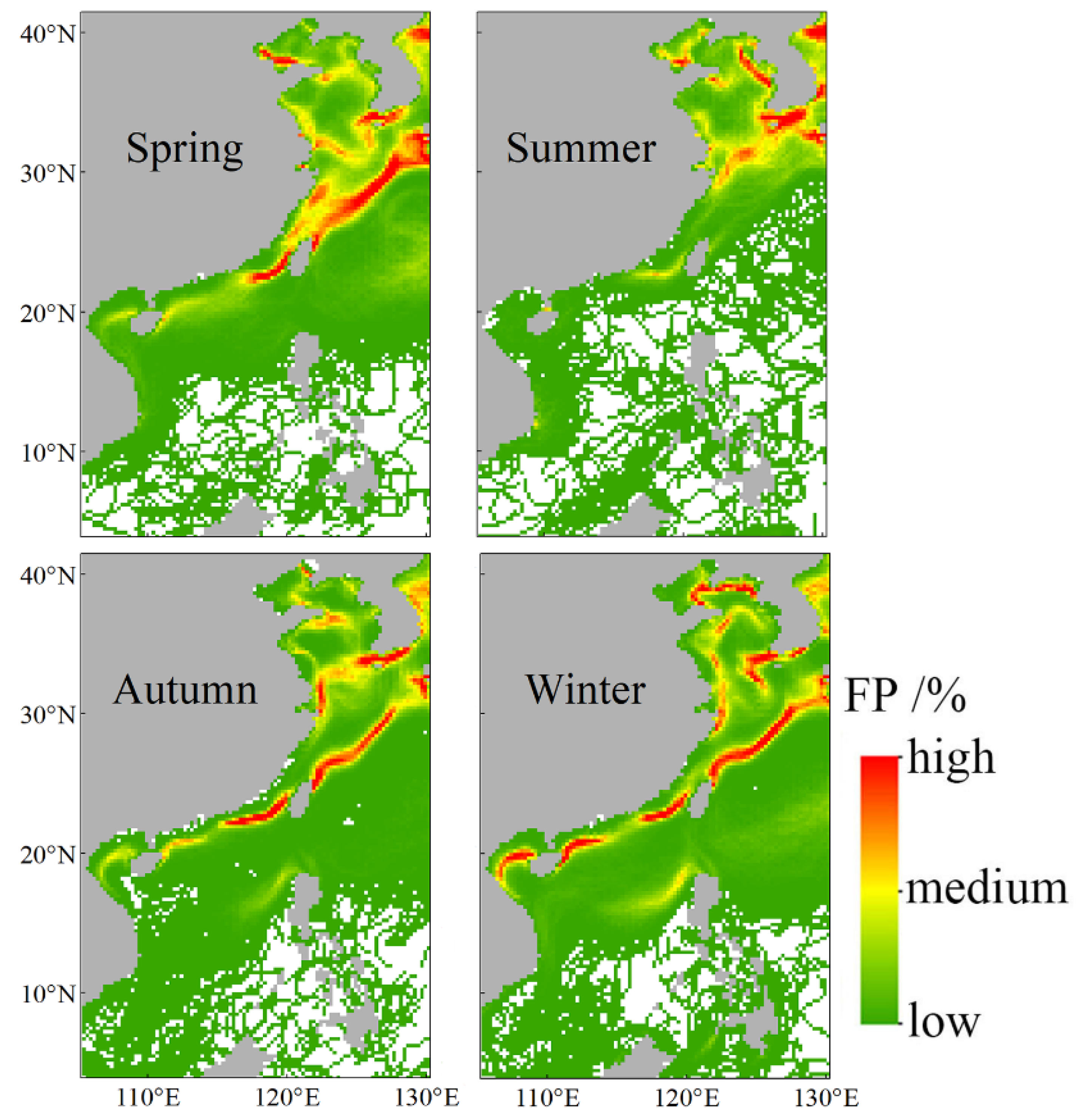
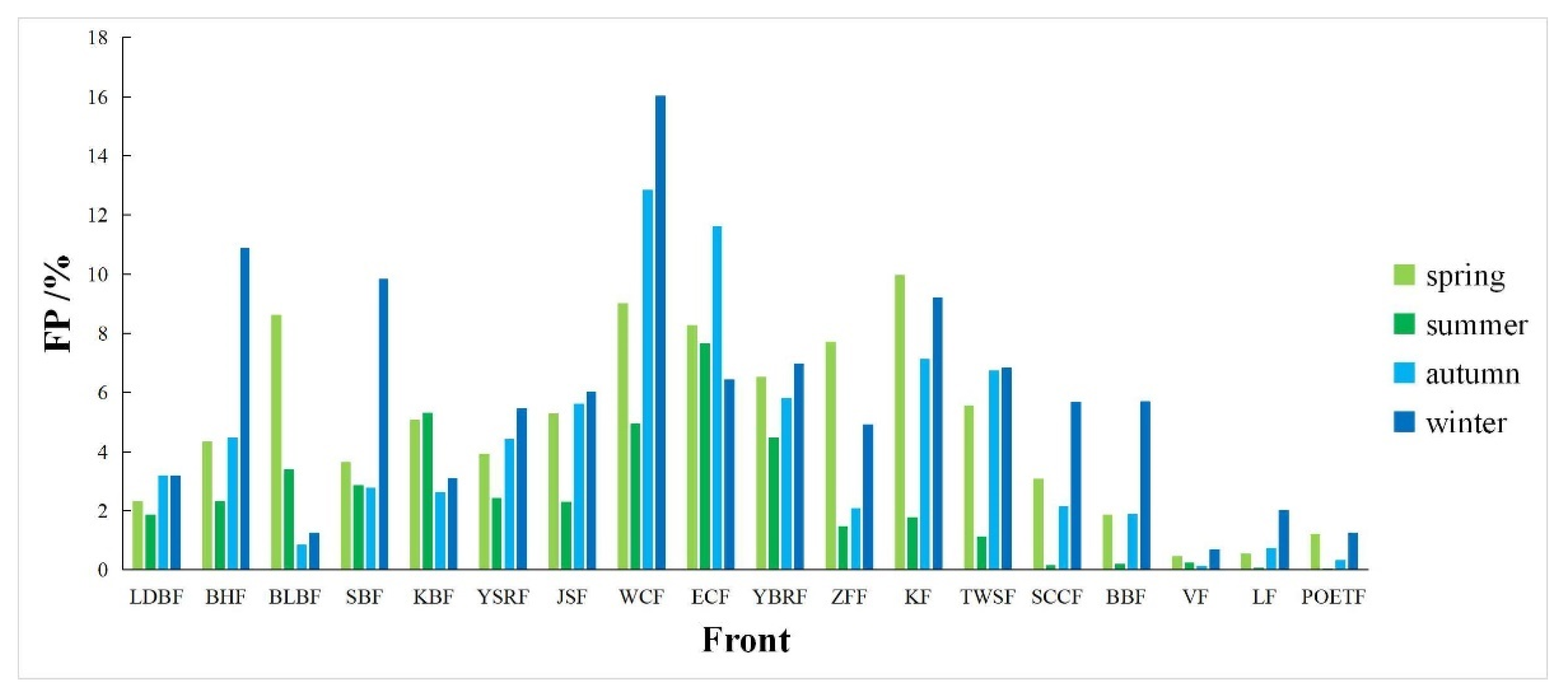
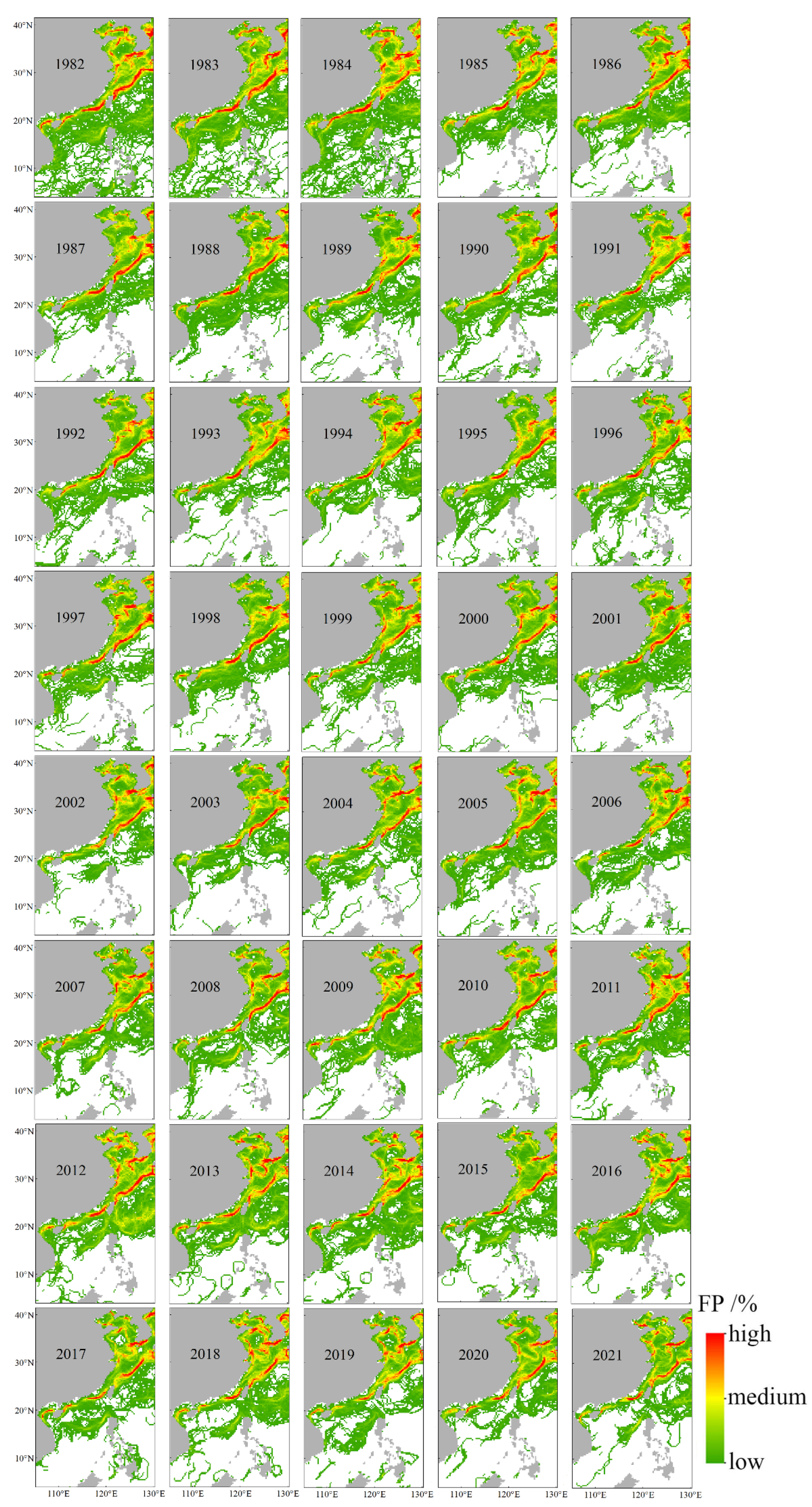

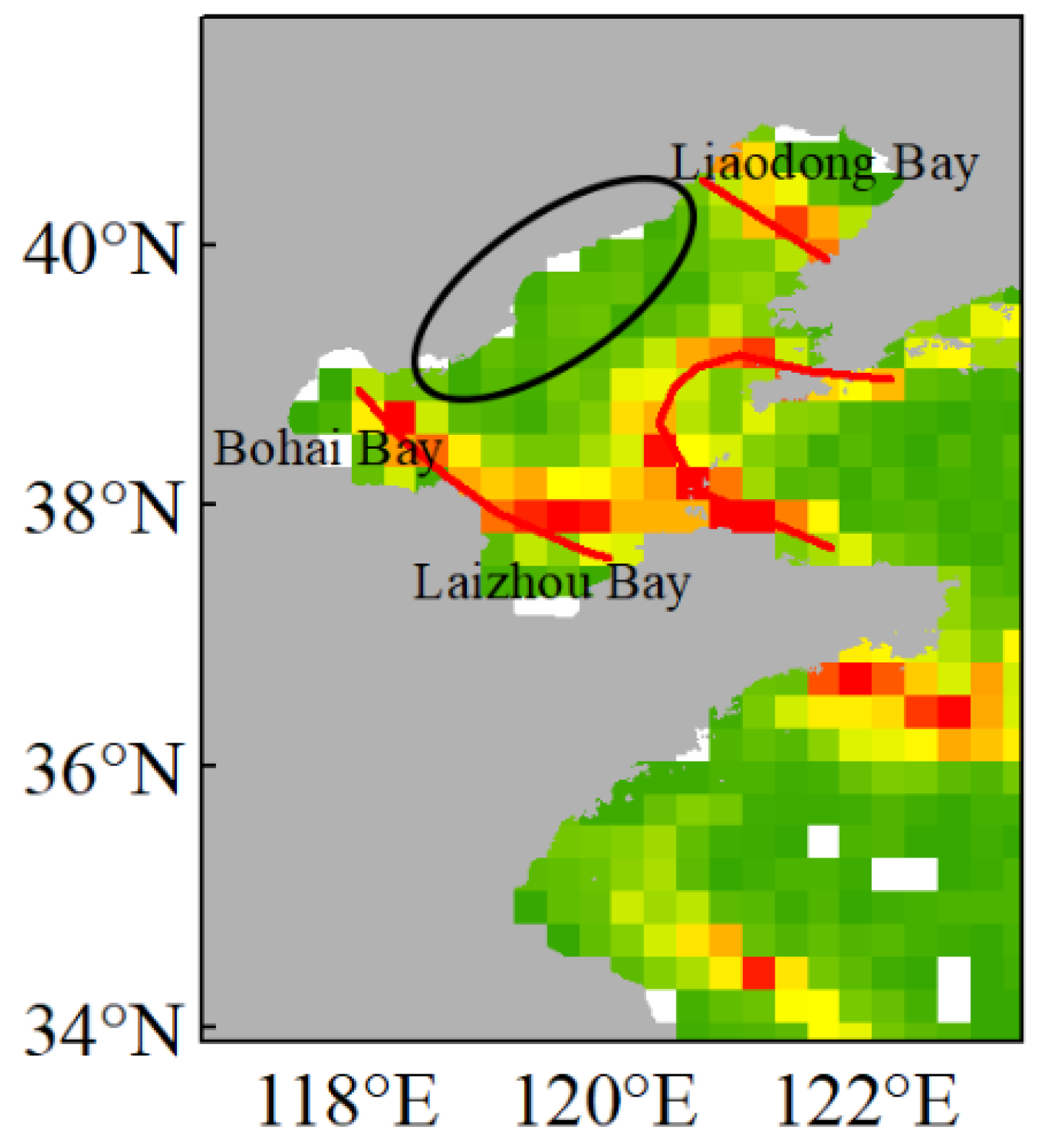

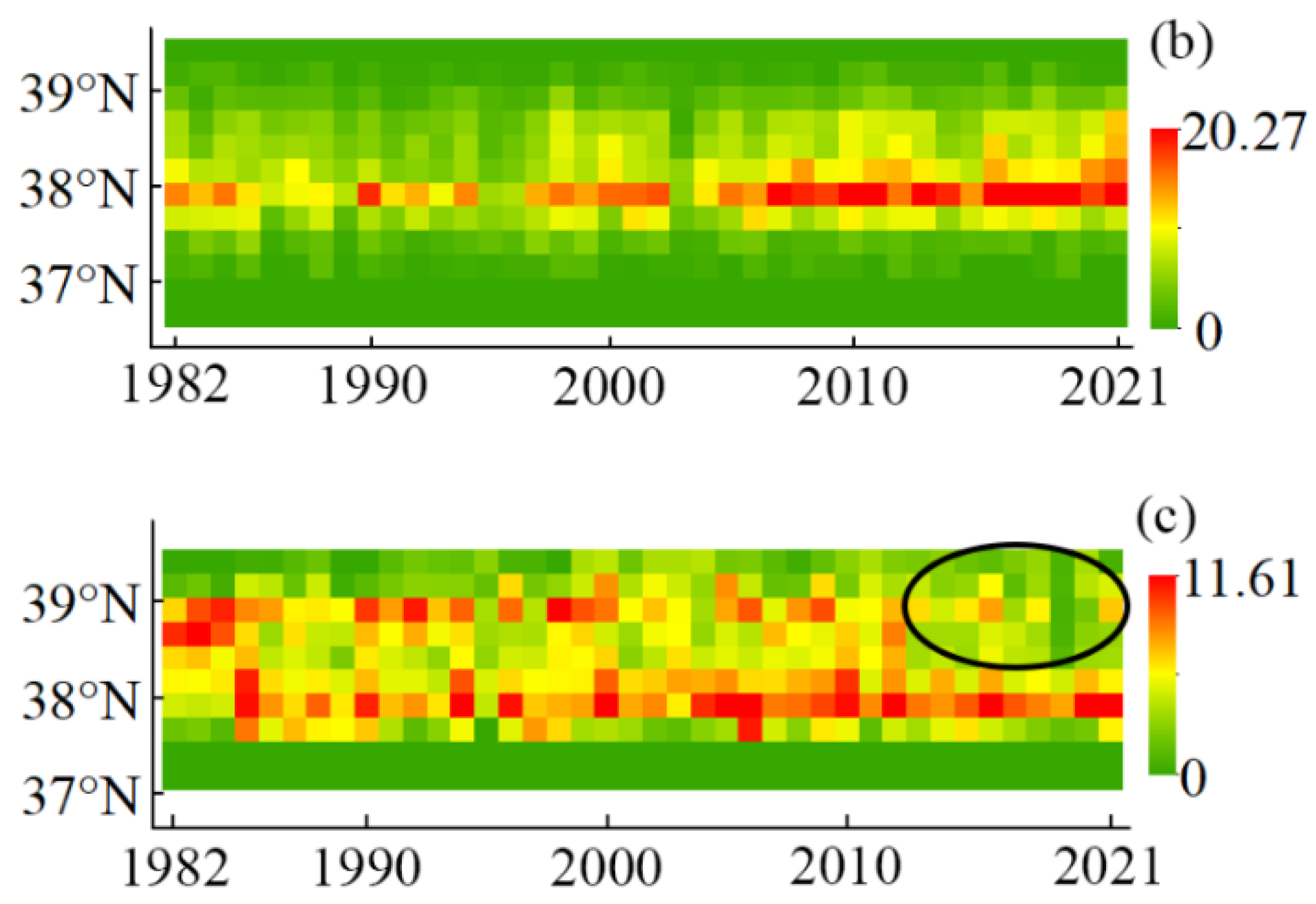
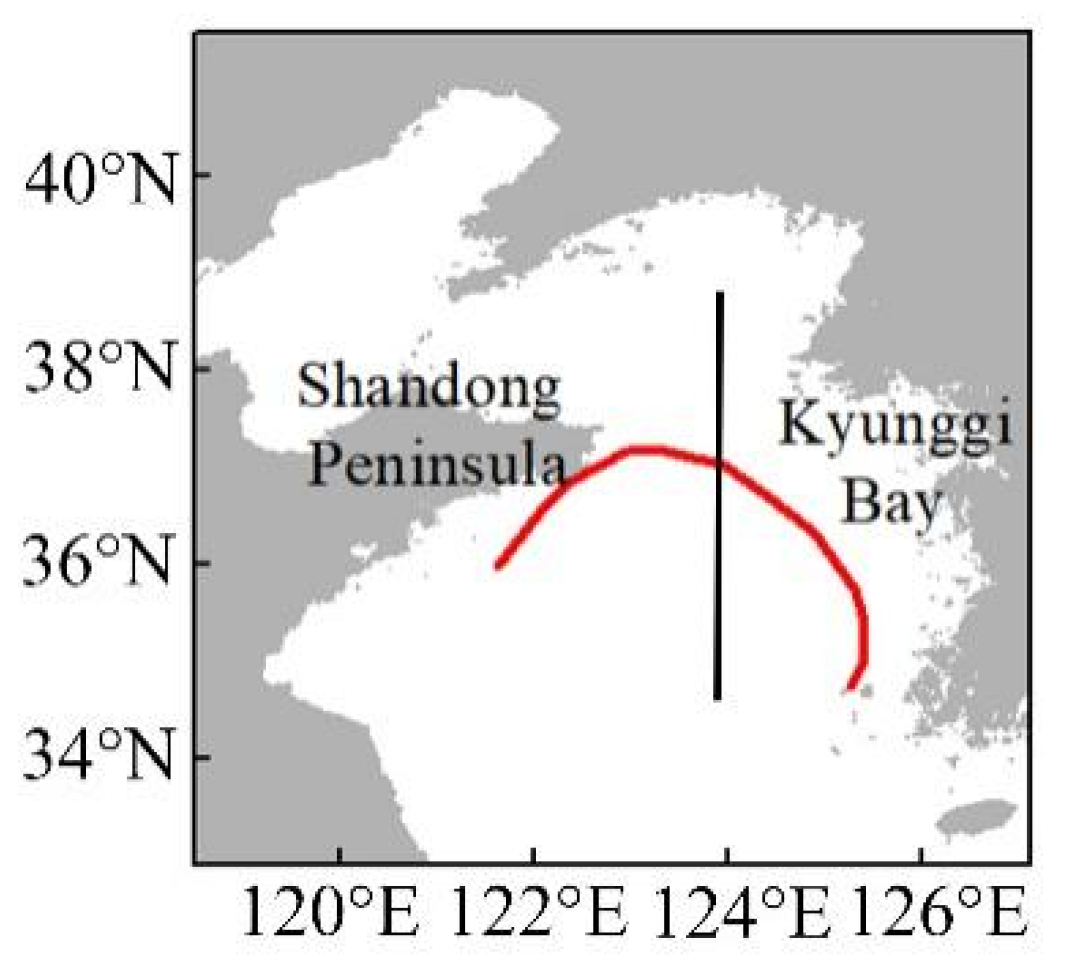
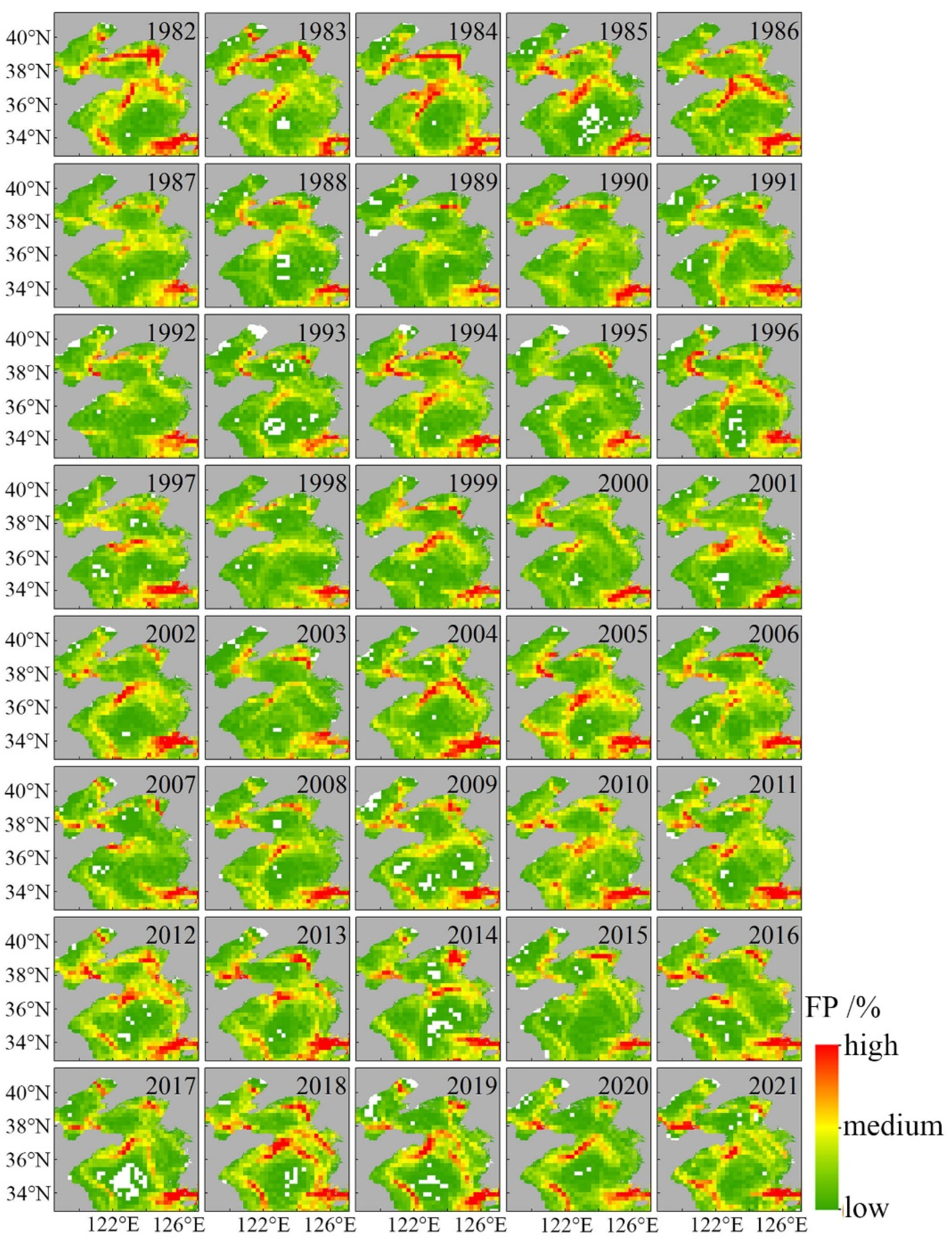
| High | Medium | Low | |
|---|---|---|---|
| January | BHF, SBF, JSF, WCF, KF, TWSF, SCCF, BBF | LDBF, YSRF, ECF, YBRF, LF | BLBF, KBF, ZFF, VF, POETF |
| February | BHF, SBF, JSF, WCF, YBRF, KF, TWSF, SCCF, BBF | YSRF, ECF, LF | BLBF, LDBF, KBF, ZFF, VF, POETF |
| March | SBF, YSRF, WCF, YBRF, KF, TWSF, SCCF, BBF | BHF, JSF, ECF, ZFF | BLBF, LDBF, KBF, LF, VF, POETF |
| April | BLBF, WCF, YBRF, ECF, KF, ZFF, TWSF, SCCF, BBF | YSRF, JSF | LDBF, BHF, SBF, KBF, LF, VF, POETF |
| May | BLBF, WCF, ECF, YBRF, JSF, KF, ZFF, TWSF | SBF, YSRF | LDBF, BHF, KBF, SCCF, BBF, LF, VF, POETF |
| June | BLBF, KBF, ECF, KF, ZFF, TWSF | LDBF, SBF, JSF, WCF, YBRF | BHF, YSRF, SCCF, BBF, LF, VF, POETF |
| July | BLBF, BHF, LDBF, SBF, KBF, JSF, YBRF, WCF, ECF | YSRF, KF, TWSF | ZFF, SCCF, BBF, LF, VF, POETF |
| August | BLBF, SBF, KBF, ECF | BHF, LDBF, YSRF, JSF, WCF, TWSF | YBRF, ZFF, KF, SCCF, BBF, LF, VF, POETF |
| September | WCF, ECF, YBRF | KBF, TWSF, YSRF | BLBF, BHF, LDBF, SBF, JSF, KF, ZFF, SCCF, BBF, LF, VF, POETF |
| October | WCF, ECF, TWSF | YBRF, KF | BLBF, BHF, LDBF, SBF, KBF, YSRF, JSF, ZFF, SCCF, BBF, LF, VF, POETF |
| November | LDBF, WCF, ECF, KF, TWSF | YSRF, YBRF | BLBF, BHF, SBF, KBF, JSF, ZFF, SCCF, BBF, LF, VF, POETF |
| December | LDBF, BHF, YSRF, JSF, WCF, ECF, KF, TWSF, SCCF, BBF | SBF, YBRF, LF | BLBF, KBF, ZFF, LF, VF, POETF |
| High | Medium | Low | |
|---|---|---|---|
| Spring | BLBF, WCF, ECF, YBRF, ZFF, KF, TWSF | LDBF, SBF, YSRF, JSF, SCCF, BBF | BHF, KBF, LF, VF, POETF |
| Summer | KBF, WCF, SBF | BLBF, BHF, LDBF, SBF, YSRF, JSF, YBRF, TWSF | ZFF, KF, SCCF, BBF, LF, VF, POETF |
| Autumn | LDBF, WCF, ECF, KF, TWSF | BHF, SBF, YSRF, JSF, YBRF, SCCF, BBF | BLBF, KBF, ZFF, LF, VF, POETF |
| Winter | BHF, SBF, WCF, KF, TWSF, SCCF, BBF | LDBF, YSRF, JSF, ECF, YBRF, LF | BLBF, KBF, ZFF, VF, POETF |
| High | Medium | Low | ||||||||||||||||
|---|---|---|---|---|---|---|---|---|---|---|---|---|---|---|---|---|---|---|
| WCF | ECF | KF | YBRF | BHF | TWSF | JSF | SBF | YSRF | ZFF | KBF | BLBF | SCCF | LDBF | BBF | LF | POETF | VF | |
| Mean FP value | 10.69 | 8.51 | 7.01 | 5.94 | 5.48 | 5.06 | 4.80 | 4.76 | 4.05 | 4.04 | 4.03 | 3.54 | 2.75 | 2.64 | 2.40 | 0.82 | 0.70 | 0.39 |
| Pattern | Year |
|---|---|
| West high–east high | 1982, 1986, 1996, 2001, 2004, 2018, 2019 |
| West high–east medium | 1984, 1985, 1994, 1997, 1999, 2002, 2005, 2008, 2010, 2011, 2012, 2013, 2014, 2020, 2021 |
| West medium–east medium | 1983, 1987, 1988, 1998, 2000, 2003, 2006, 2009, 2015 |
| West medium–east low | 1989, 1990, 1991, 1992, 1993, 1995, 2007, 2016, 2017 |
Publisher’s Note: MDPI stays neutral with regard to jurisdictional claims in published maps and institutional affiliations. |
© 2022 by the authors. Licensee MDPI, Basel, Switzerland. This article is an open access article distributed under the terms and conditions of the Creative Commons Attribution (CC BY) license (https://creativecommons.org/licenses/by/4.0/).
Share and Cite
Zhao, L.; Yang, D.; Zhong, R.; Yin, X. Interannual, Seasonal, and Monthly Variability of Sea Surface Temperature Fronts in Offshore China from 1982–2021. Remote Sens. 2022, 14, 5336. https://doi.org/10.3390/rs14215336
Zhao L, Yang D, Zhong R, Yin X. Interannual, Seasonal, and Monthly Variability of Sea Surface Temperature Fronts in Offshore China from 1982–2021. Remote Sensing. 2022; 14(21):5336. https://doi.org/10.3390/rs14215336
Chicago/Turabian StyleZhao, Linhong, Dingtian Yang, Rong Zhong, and Xiaoqing Yin. 2022. "Interannual, Seasonal, and Monthly Variability of Sea Surface Temperature Fronts in Offshore China from 1982–2021" Remote Sensing 14, no. 21: 5336. https://doi.org/10.3390/rs14215336
APA StyleZhao, L., Yang, D., Zhong, R., & Yin, X. (2022). Interannual, Seasonal, and Monthly Variability of Sea Surface Temperature Fronts in Offshore China from 1982–2021. Remote Sensing, 14(21), 5336. https://doi.org/10.3390/rs14215336





